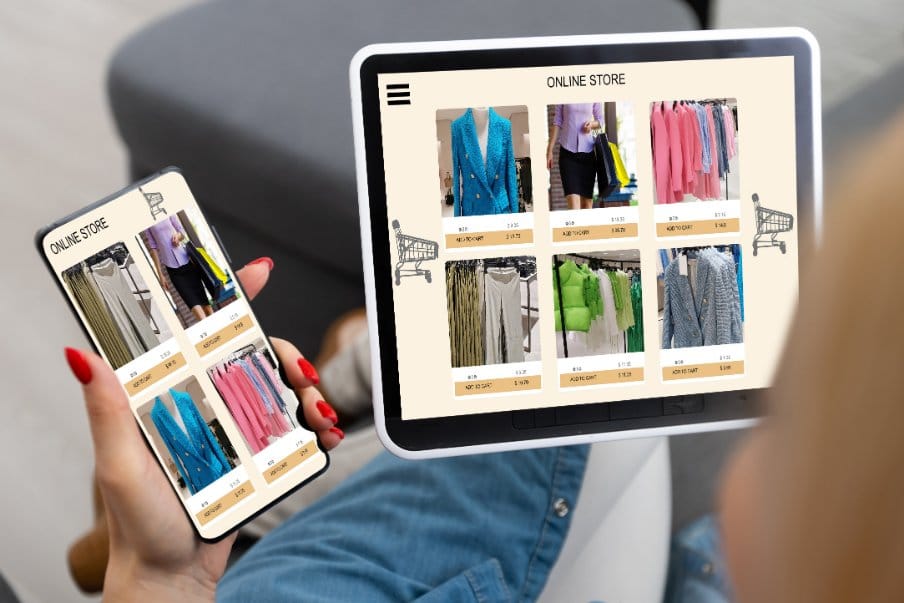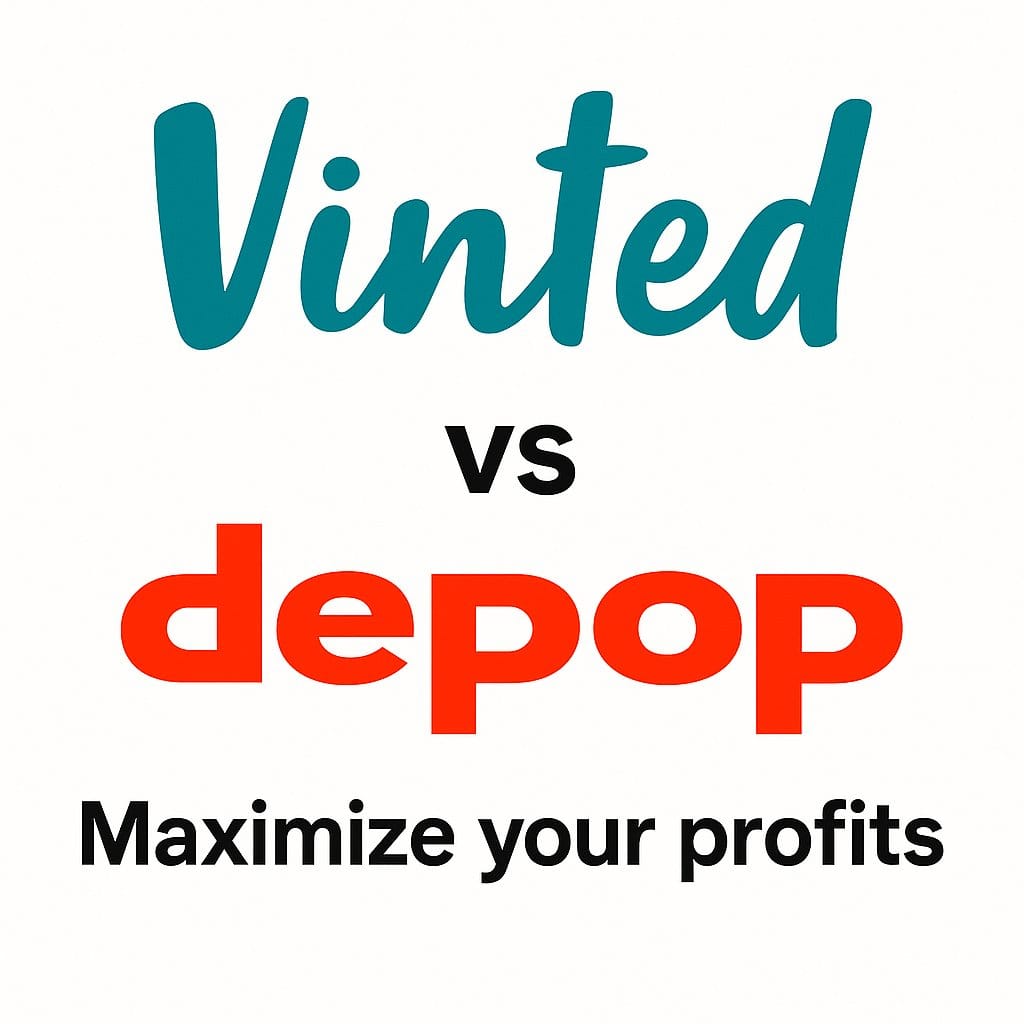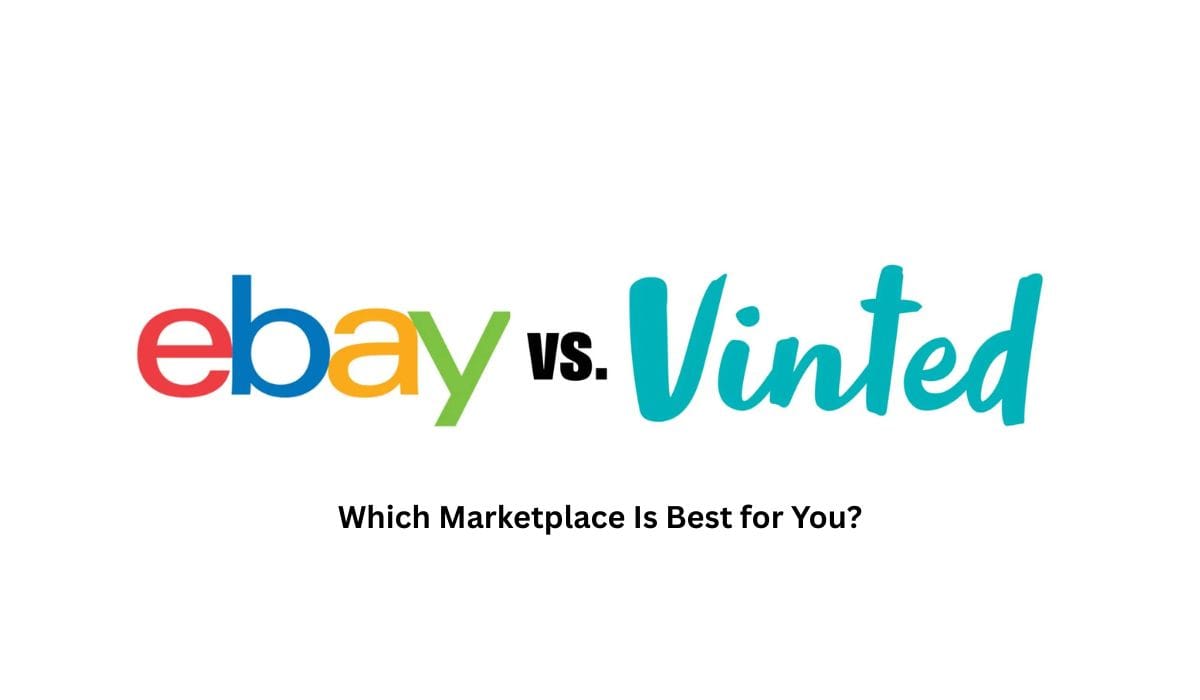Maximize Your Secondhand Fashion Profits: Expert Comparison of Fees, Audiences, and Selling Strategies
If you want to clear out your closet and make extra cash, selling clothes online through apps like Depop and Vinted is a popular choice. Both offer easy ways to list your clothes, reach new buyers, and manage sales from your phone. The biggest difference is that Vinted has no selling fees for sellers, while Depop charges a fee per sale.
The two platforms have different communities and styles. Depop is known for trendy, unique, and vintage clothes, while Vinted leans toward affordable, everyday items. Your selling experience will depend on what you’re listing and the kind of customers you want to reach.
Table of Contents
Key Takeaways
- You can sell clothes on both Depop and Vinted using your phone
- Vinted doesn’t charge seller fees, but Depop does
- Each app has its own style and type of buyers
- Tax implications matter for sellers earning over $600 annually
- Cross-platform selling can maximize your profits
Overview of Depop and Vinted
Depop and Vinted are two of the most popular platforms for selling second-hand clothes online. Each app has its own way of connecting sellers with buyers and handling pre-owned clothing sales.
About Depop
Depop is a mobile app focused on selling clothes, especially for younger users interested in fashion trends and unique styles. You can list your pre-owned clothes by uploading photos, adding descriptions, and setting prices.
The platform looks like a mix between a shopping app and social media. You can follow other users, like items, and even use hashtags to make your listings easier to find. This makes Depop popular with people who want to show off their style or have a personal brand.
Depop charges a fee for each sale, so you need to factor that into your prices. Many sellers use features such as item “bumping” or promotions to boost visibility in search results. Overall, Depop works best if you have trendy or in-demand clothes, as buyers often search for specific brands and styles.
About Vinted
Vinted is also an app focused on second-hand clothing, but it is known for its simple and straightforward experience. Listing items is free, and Vinted does not charge selling fees, which makes it more cost-effective for sellers.
Buyers pay for shipping and protection, so your earnings are not reduced by hidden costs. The app is designed for quick sales and offers basic categories for listing your items. Most Vinted users are looking for affordable everyday clothes rather than high-end or rare pieces.
The buyer and seller communication is simple, and transactions are handled directly through the app. You do not need to be highly active or promote your listings, making Vinted a good option if you want a more hands-off way to sell your clothes online.
Is Vinted or Depop More Popular in America?
Both platforms have significant user bases across the country, but their popularity varies by demographic and region. Depop maintains a strong presence among college students and young professionals in major cities like New York, Los Angeles, and Austin. The platform’s social media-style interface appeals particularly to Gen Z users who grew up with Instagram and TikTok.
Vinted has experienced rapid growth nationwide, especially in suburban areas and among users aged 25-40. The platform’s appeal stems from its practical approach to decluttering and the absence of seller fees, which resonates with budget-conscious families.
Recent market data suggests Vinted’s user base has grown by approximately 150% over the past two years, while Depop’s growth has been more modest at around 40%. This shift reflects changing consumer priorities, with more people prioritizing practical savings over social engagement when selling clothes.
Why Did Vinted Overtake Depop in Many Markets?
Several factors contributed to Vinted’s rapid expansion:
- Zero Seller Fees: The most significant advantage is Vinted’s commitment to not charging sellers any commission. This policy allows sellers to keep 100% of their listing price, making it especially attractive for lower-priced items where Depop’s 10% fee significantly impacts profits.
- Simplified User Experience: Vinted streamlined the selling process by removing social features that many casual sellers found overwhelming. The platform focuses purely on transactions rather than community building.
- Broader Item Acceptance: While Depop emphasizes fashion-forward items, Vinted accepts a wider range of clothing conditions and styles, making it accessible to more sellers.
- Automated Shipping Solutions: Vinted’s integrated shipping system removes complexity for sellers, while Depop initially required more manual shipping management.
Key Differences
- Selling Fees: Depop charges a 10% fee on each sale, which can affect your profits. Vinted does not charge these fees, letting you keep the full selling price.
- Audience: Depop attracts buyers looking for trendy and vintage clothes, often targeting young adults and teens. Vinted customers usually want affordable, practical second-hand clothing.
- Platform Features: Depop uses social features, like user profiles and activity feeds, to help sellers build a following. Vinted is more transactional with fewer social networking options.
| Feature | Depop | Vinted |
|---|---|---|
| Selling Fees | 10% per sale | No seller fees |
| Audience | Trendy, younger buyers | Bargain-seekers |
| Listing Process | Social, promotional | Simple, straightforward |
| Best For | Unique, on-trend items | Everyday clothes |
| Payment Processing | Depop Payments/PayPal | Integrated system |
| Shipping Labels | Optional/Self-managed | Always provided |
Your choice between Depop and Vinted depends on what kinds of clothes you want to sell and how involved you want to be in the selling process.
What Should Be Sold on Both Platforms?

Understanding what performs best on each platform can significantly impact your selling success and profit margins.
Items That Thrive on Depop
- Designer and Luxury Pieces: Authentic designer handbags, shoes, and clothing from brands like Gucci, Louis Vuitton, or Balenciaga perform exceptionally well. Buyers on Depop are willing to pay premium prices for authenticated luxury items.
- Vintage and Y2K Fashion: Items from the 1990s and early 2000s, including low-rise jeans, crop tops, and vintage band t-shirts, consistently sell quickly. Vintage Levi’s, band merchandise, and unique thrift finds are particularly sought after.
- Streetwear and Hype Brands: Supreme, Off-White, Palace, and other streetwear brands command high prices. Limited edition sneakers and collaboration pieces often sell within hours of listing.
- Alternative and Aesthetic Clothing: Gothic, cottagecore, dark academia, and other niche aesthetic items find their audience on Depop’s style-conscious community.
Items That Excel on Vinted
- Everyday Basics: Gap, Old Navy, Target, and other mainstream brand basics like plain t-shirts, jeans, and sweaters sell consistently well due to Vinted’s practical user base.
- Children’s Clothing: Parents frequently use Vinted to buy and sell kids’ clothes that are quickly outgrown. Brand names like Carter’s, Gymboree, and Disney-themed items are popular.
- Plus-Size Options: Vinted has a strong market for plus-size clothing, especially from brands like Torrid, Lane Bryant, and ASOS Curve.
- Professional Wear: Business casual and formal clothing from brands like Ann Taylor, Banana Republic, and Express appeal to working professionals seeking affordable work attire.
Items to Avoid on Both Platforms
Both platforms prohibit certain items including counterfeit goods, used underwear, and items with strong odors or significant damage. Additionally, avoid listing items that require authentication unless you can provide proper documentation.
Getting Started With Selling on Depop and Vinted

To begin selling on Depop or Vinted, you need to create an account and go through steps to prove your identity. Both platforms use several measures to make their marketplaces safe, secure, and simple for sellers.
Setting Up an Account
Registering on Depop or Vinted is quick. You can sign up using an email address, Google account, Apple ID, or social media login.
After entering your information, you’ll be asked to agree to the platform’s terms. You must provide basic personal data like your name, email, and sometimes your phone number. A strong password is required. Both sites may record your IP address and general location for security.
It’s best to use an email you check often. Notifications about sales, offers, and questions from buyers will be sent there. Double-check your details for accuracy to avoid issues accessing your account later. Once your profile is complete, add payment method details. PayPal and direct deposit are common options.
Verifying Identity and Authenticating Users
To help prevent spam and fake accounts, Depop and Vinted often ask you to verify your identity. You may need to confirm your phone number or email, and in some cases, upload a photo of a government ID.
These steps help protect the community and keep the marketplace secure. Platforms may use your IP address and geolocation data to make sure your account isn’t being accessed from an unusual place.
Security measures like two-factor authentication (2FA) are sometimes offered or required. Turning on 2FA can help keep your account safe. Your personal data, including precise geolocation data, is protected by privacy policies, but always review these before uploading sensitive information. Authentication processes can differ, so follow the on-screen prompts for the best results.
Tax Considerations for Sellers
If you’re planning to sell regularly, understanding tax implications is crucial. The IRS requires platforms to send 1099-K forms to sellers who receive over $600 in payments during a tax year. This applies to both Depop and Vinted sales.
Keep detailed records of your sales, including purchase prices, selling prices, and any business expenses like shipping supplies or photography equipment. Many casual sellers qualify for hobby loss rules, but if you’re consistently profitable, you may need to treat your selling as a business.
Consider using a spreadsheet or app like QuickBooks Self-Employed to track your income and expenses. Consult with a tax professional if you’re earning substantial income from selling clothes.
Which Platform Has Better Listing Options?

The listing experience differs significantly between platforms, affecting how much time you’ll spend managing your inventory.
Depop’s Advanced Listing Features
Depop offers more sophisticated listing tools that appeal to sellers building a brand:
- Enhanced Photo Editing: Built-in filters and editing tools help create cohesive brand aesthetics. You can adjust brightness, contrast, and apply filters directly within the app.
- Detailed Categorization: More specific subcategories help buyers find exactly what they’re looking for. You can list items under precise categories like “Y2K tops” or “cottagecore dresses.”
- Social Integration: Cross-posting to Instagram and other social platforms happens seamlessly, expanding your reach beyond Depop’s user base.
- Listing Templates: Save frequently used descriptions and formats to speed up the listing process for similar items.
Vinted’s Streamlined Approach
Vinted prioritizes simplicity and speed:
- Quick Listing Process: The streamlined interface allows you to list items in under two minutes. Pre-filled size and brand options speed up data entry.
- Automatic Suggestions: The app suggests categories, brands, and even prices based on your photos, reducing manual input.
- Bulk Editing Tools: Modify multiple listings simultaneously, including price adjustments and description updates.
- Size Guide Integration: Built-in size conversion tools help international buyers understand sizing.
Winner: Depends on Your Goals
Choose Depop if you want creative control and plan to build a recognizable brand. Choose Vinted if you prioritize efficiency and want to list items quickly without extensive customization.
Listing Clothes for Sale

Getting your unwanted clothes ready to sell takes more than just snapping a photo. The way you describe your items and the quality of your pictures are both important for attracting buyers.
Creating Item Descriptions
An effective item description should clearly tell buyers what your listing includes. Start with the brand, size, color, and condition of the second-hand clothes. If the item is pre-owned, mention any flaws like stains, holes, or fading. This builds trust and lowers the chance of returns.
Keep your description short but detailed. Use bullet points for important facts:
- Brand and size
- Color
- Type of clothing (e.g., jeans, jacket)
- Material
- Condition (new, gently worn, or worn)
- Any defects or special features
On Vinted and Depop, buyers search using keywords. Use keywords that reflect the style, fit, or trend. For example, “oversized Nike hoodie” tells buyers what to expect. Avoid long paragraphs. Make it easy for someone to skim and find the details they need.
Advanced Description Strategies
- Seasonal Optimization: Include seasonal keywords when relevant. Words like “summer,” “back-to-school,” or “holiday party” can increase visibility during peak shopping periods.
- Style Keywords: Research trending terms on social media. Words like “coastal grandmother,” “dark academia,” or “cottagecore” help your items appear in trend-based searches.
- Fit Information: Include measurements for bust, waist, and length when possible. Many buyers have been disappointed by inaccurate sizing, so detailed measurements build trust.
- Story Selling: Briefly mention where you wore the item or why you loved it. “Perfect for music festivals” or “great for office wear” helps buyers visualize themselves wearing it.
Taking Photos and Showcasing Clothing
Photos help buyers see exactly what they’re getting. Use a simple, clean background to make the clothing stand out. Natural lighting works best, avoid photos that are dark or have harsh shadows.
Take pictures from different angles: front, back, and close-ups of details or any flaws. Show a clear shot of labels for brand proof and sizing. You can also lay the item flat or show it on a hanger. If possible, include a photo of the item being worn.
Make sure the clothes look tidy, iron them if needed. Blurry photos or poor lighting can make your listing less appealing. High-quality images can lead to more interest and better chances of selling your items quickly.
Professional Photography Tips
- Lighting Setup: Position yourself near a large window during daylight hours. Avoid direct sunlight which creates harsh shadows. Overcast days actually provide the most even lighting.
- Background Choices: White walls, bedsheets, or poster boards create clean backgrounds. Some sellers invest in photography backdrops for consistency across listings.
- Styling Props: Simple accessories like jewelry or shoes can help buyers visualize complete outfits, but don’t overshadow the main item.
- Photo Sequence: Lead with your strongest image, typically a front-facing shot with good lighting. Follow with back views, detail shots, and any flaw documentation.
Pricing and Profit Considerations

Selling on Depop or Vinted means paying close attention to your pricing and understanding how fees can impact your earnings. Marketplace rules and how you set your prices both play important roles in your final profit.
Setting Prices for Maximum Profit
When setting prices, look at similar listings on the platform. Notice what items like yours are selling for, not just what sellers are asking. Pricing your item a bit below popular listings can help it sell faster.
Factor in the condition, brand, and demand for each item. If your item is in great shape, you might get away with a higher price. But if it’s worn or a lesser-known brand, you’ll want to price it lower.
Consider all extra costs, such as shipping and packaging. On Vinted, buyers often pay for shipping, but on Depop, sellers might need to cover this. If you offer free shipping, include that cost in your price to keep your net profit higher.
Regularly review your prices. If something isn’t selling, even a small price drop can make your listing more attractive. Watch for season changes, too warm clothes sell better in winter.
Strategic Pricing by Platform
- Depop Pricing Strategy: Since Depop takes 10%, price items at least 15-20% higher than your minimum acceptable profit to account for fees and potential offers. Trendy items can command premium prices, sometimes 200-300% of retail value for rare vintage pieces.
- Vinted Pricing Strategy: Without seller fees, you can price more competitively while maintaining the same profit margins. Consider pricing 10-15% below comparable Depop listings to attract price-sensitive buyers.
- Cross-Platform Pricing: If selling on both platforms, price Depop listings slightly higher to account for fees, but ensure Vinted prices remain competitive to maximize your advantage on the fee-free platform.
Understanding Marketplace Fee Structures
Depop charges a 10% seller fee on each sale. There may also be PayPal fees depending on your location. This means if you sell an item for $20, Depop takes $2, and PayPal could take a small extra fee.
Vinted does not charge seller fees. You keep the full price of the item, so your net profit is higher per sale. However, Vinted may earn some money through optional buyer protection or premium features, not from sellers directly.
What Percentage of a Sale Does Vinted Take?
Vinted takes 0% commission from sellers, which is their main competitive advantage. Instead, Vinted generates revenue through buyer protection fees, premium features, and advertising options that sellers can choose to purchase.
Buyers pay a protection fee (typically 3-8% of the item price plus a fixed fee) and shipping costs. This fee structure means sellers receive exactly what they listed the item for, making profit calculations straightforward.
The absence of seller fees makes Vinted particularly attractive for lower-priced items where a 10% commission would significantly impact profitability.
Payment Processing and Banking
- Depop Payments: Depop’s integrated payment system processes most transactions, with funds typically available within 2-4 business days. International sales may take longer to process.
- Vinted Payments: Funds are released after the buyer confirms receipt or after 14 days automatically. Vinted holds payments briefly to ensure transaction security and buyer satisfaction.
- Bank Transfer Options: Both platforms offer direct deposit to checking accounts. Setting up direct deposit eliminates PayPal fees and provides faster access to funds.
Use the table below for a quick fee breakdown:
| Platform | Seller Fee | Additional Fees | Who Pays Shipping? |
|---|---|---|---|
| Depop | 10% | PayPal/Payment fees | Seller or buyer |
| Vinted | $0 | Buyer protection fees* | Usually buyer |
*Usually paid by buyers, not sellers.
Knowing these fee structures lets you set prices with confidence and avoid losing money. Always factor in all possible charges before finalizing your price.
What Sells for the Most Money on Each Platform?
High-Value Depop Categories:
- Authentic designer handbags: $200-$2,000+
- Vintage band t-shirts: $50-$300
- Limited edition sneakers: $150-$1,000+
- Y2K designer pieces: $80-$500
High-Value Vinted Categories:
- Quality winter coats: $40-$150
- Professional work wear sets: $30-$100
- Children’s designer clothing lots: $50-$200
- Athletic wear bundles: $40-$120
Can I Sell on Both Vinted and Depop?

Yes, cross-platform selling is not only allowed but often recommended for maximizing your reach and profits. Many successful sellers use both platforms strategically.
Benefits of Multi-Platform Selling
- Expanded Audience Reach: Depop’s trend-focused buyers and Vinted’s practical shoppers often seek different items, allowing you to tap into multiple market segments.
- Risk Mitigation: If one platform experiences technical issues or policy changes, your sales continue on the other platform.
- Price Optimization: Test different price points on each platform to find optimal pricing for similar items.
- Inventory Turnover: Items that don’t sell well on one platform might perform better on the other due to different audience preferences.
Cross-Platform Management Strategies
- Inventory Tracking: Use a simple spreadsheet to track which items are listed where and their status. Remove listings immediately when items sell to avoid overselling.
- Price Differentiation: Account for Depop’s fees by pricing items slightly higher there, while keeping Vinted prices competitive.
- Description Adaptation: Tailor descriptions to each platform’s audience. Use trendy language and hashtags for Depop, straightforward descriptions for Vinted.
- Photo Consistency: Use the same high-quality photos across platforms to maintain brand consistency and save time.
Potential Challenges
- Time Management: Managing listings across multiple platforms requires more time for posting, updating, and communicating with buyers.
- Inventory Confusion: Risk of selling the same item twice if you don’t immediately update all platforms when something sells.
- Platform-Specific Policies: Each platform has different rules about messaging, returns, and prohibited items that you must follow.
Shipping, Delivery, and Packaging

Selling on Depop and Vinted involves managing how your items get to buyers and how you prepare them for shipping. The process, costs, and tools each platform offers can impact your sales and customer reviews.
Who Pays for Shipping on Both Platforms?
- Depop Shipping Responsibility: On Depop, shipping arrangements are flexible. You can choose to include shipping costs in your item price (offering “free shipping” to buyers) or charge shipping separately. When using Depop’s shipping labels, buyers pay the shipping cost directly at checkout. If you handle shipping independently, you can set your own shipping rates.
- Vinted Shipping Structure: Vinted simplifies shipping by having buyers pay all shipping costs directly. The platform calculates shipping fees based on package weight and destination, and buyers see these costs before completing their purchase. Sellers never pay for shipping unless they choose to offer it as an incentive.
Postage and Delivery Options
Depop puts you in charge of shipping arrangements. You decide if you want to use Depop’s prepaid labels or ship items yourself and set your own rates. If you use their labels, buyers pay for shipping, and you print the label at home. If you ship on your own, you need to handle postage and tracking and provide shipping info to buyers.
On Vinted, shipping is more automated. Buyers choose a delivery method at checkout, and Vinted provides you with a prepaid label. The platform takes care of postage costs; you only need to pack the item, stick on the label, and drop it off at a delivery point. This process reduces confusion and helps keep things clear for both you and your customer.
Shipping Speed and Options
- Depop Delivery Timeframes: Standard shipping typically takes 3-7 business days, with expedited options available for an additional fee. Priority Mail and Priority Mail Express offer faster delivery for urgent purchases.
- Vinted Delivery Options: Vinted partners with various carriers including USPS and UPS. Standard delivery ranges from 2-5 business days depending on distance. Some areas have next-day delivery options for an additional fee.
- International Shipping: Both platforms support international sales, though Depop offers more flexibility in setting international shipping rates. Vinted handles international shipping calculations automatically.
| Platform | Who Handles Postage? | Shipping Labels |
|---|---|---|
| Depop | Seller or Depop | Optional/Provided |
| Vinted | Vinted (prepaid) | Always Provided |
Packaging Tips for Secure Shipping
Use packaging that protects clothing from dirt, moisture, and rough handling. Clean mailing bags or sturdy boxes work best for most clothes. It’s a good idea to fold items neatly and consider wrapping them in tissue paper or a clean plastic bag for extra protection.
Check that your packaging is the right size to avoid extra postage costs or damage. Always seal packages well with tape. Attach labels clearly and double-check the shipping info to avoid mistakes. You can also add a thank you note or small freebie to make a good impression, but focus first on keeping the item safe until it arrives.
Professional Packaging Standards
- Branding Opportunities: Custom stickers, thank you cards, or branded mailers can help build customer loyalty and encourage repeat purchases.
- Sustainable Packaging: Many buyers appreciate eco-friendly packaging options like biodegradable mailers or reused packaging materials.
- Protection Levels: Delicate items like jewelry or structured handbags need extra padding. Use bubble wrap or packing paper for items that could be damaged in transit.
- Cost-Effective Solutions: Buy packaging supplies in bulk from warehouse stores or online suppliers to reduce per-package costs.
How Do Returns and Refunds Work on Both Platforms?

Understanding each platform’s return policy is crucial for managing buyer expectations and protecting your seller reputation.
Depop’s Return Policy
Depop doesn’t have a standardized return policy, leaving return terms largely up to individual sellers. However, buyers can open disputes through PayPal or their payment method if items are significantly not as described.
- Seller-Controlled Returns: You can set your own return policy in your shop description. Many sellers offer returns within 3-7 days for items that don’t fit, while others maintain strict no-return policies.
- Dispute Resolution: If buyers claim items are not as described, Depop’s support team mediates disputes. Having detailed photos and descriptions protects you in these situations.
- Best Practices: Clearly state your return policy in item descriptions and shop policies. Consider offering returns for higher-priced items to increase buyer confidence.
Vinted’s Buyer Protection System
Vinted offers more structured buyer protection, which can work in favor of both buyers and sellers when issues arise.
- Two-Day Inspection Period: Buyers have 48 hours after delivery to report any issues with their purchase. During this time, funds are held in escrow.
- Issue Resolution Process: If buyers report problems, Vinted mediates between both parties. Common resolutions include partial refunds, return shipping, or full refunds with return.
- Seller Protection: If items are returned in different condition than sent, Vinted’s team reviews evidence and may rule in favor of sellers.
- Automatic Release: If no issues are reported within 48 hours, funds are automatically released to sellers.
Managing Returns Strategically
- Documentation: Always take photos of items before shipping as evidence of condition. This protects you if buyers claim items arrived damaged.
- Communication: Respond quickly to buyer concerns and work toward amicable solutions. Good customer service often prevents negative reviews.
- Quality Control: Inspect items carefully before listing to avoid returns due to undisclosed damage or wear.
Advantages and Disadvantages of Both Platforms

Understanding the complete picture of each platform’s strengths and weaknesses helps you make informed decisions about where to invest your selling efforts.
Depop Advantages
- Higher Profit Potential: Trendy and unique items often sell for premium prices, sometimes exceeding original retail value.
- Brand Building Opportunities: Social features allow you to develop a recognizable brand and loyal customer following.
- Creative Control: Extensive customization options for shop aesthetics and item presentation.
- International Reach: Strong presence in multiple countries expands your potential buyer base.
- Community Engagement: Active community of fashion enthusiasts who share and promote each other’s items.
Depop Disadvantages
- High Competition: Saturated market makes it challenging for new sellers to gain visibility.
- Time Investment: Social aspects require regular engagement and content creation to maintain visibility.
- Fee Structure: 10% commission plus payment processing fees reduce profit margins.
- Trend Dependency: Success heavily relies on understanding and predicting fashion trends.
- Seasonal Fluctuations: Sales often drop during off-peak fashion seasons.
Vinted Advantages
- Zero Seller Fees: Keep 100% of your listing price, maximizing profit margins.
- Simplified Process: Straightforward listing and selling process requires minimal time investment.
- Broad Item Acceptance: Less restrictive about item condition and style, accepting everyday clothing.
- Automated Systems: Integrated shipping and payment processing reduce administrative tasks.
- Growing User Base: Rapidly expanding market share provides increasing buyer traffic.
Vinted Disadvantages
- Lower Price Points: Buyers expect bargain prices, limiting profit potential for premium items.
- Limited Branding: Minimal opportunities to build a recognizable seller brand or following.
- Algorithm Dependency: Less control over listing visibility compared to Depop’s social features.
- Regional Limitations: Newer to some markets with less established buyer bases.
- Category Restrictions: Some limitations on luxury or high-value item sales.
What Sells the Most on Both Platforms?

Understanding top-performing categories helps you focus your efforts on items most likely to sell quickly and profitably.
Depop’s Best-Selling Categories
- Vintage Denim: Levi’s 501s, vintage Wranglers, and 90s mom jeans consistently rank among top sellers. Price range: $30-$150.
- Band and Graphic Tees: Vintage concert tees, especially from popular bands like Nirvana, The Beatles, or modern artists, sell rapidly. Price range: $25-$200.
- Designer Accessories: Authentic luxury handbags, shoes, and jewelry from brands like Coach, Michael Kors, or Tiffany & Co. Price range: $50-$2,000+.
- Y2K Fashion: Low-rise jeans, baby tees, platform shoes, and anything reminiscent of early 2000s style. Price range: $20-$100.
- Cottagecore and Aesthetic Items: Flowing dresses, cardigans, and items fitting popular aesthetic trends. Price range: $25-$80.
Vinted’s Top-Performing Items
- Children’s Clothing: Kids outgrow clothes quickly, creating steady demand for gently used items. Popular brands include Carter’s, OshKosh, and Disney. Price range: $5-$25.
- Everyday Basics: Plain t-shirts, jeans, and sweaters from mainstream brands like Gap, Old Navy, and Target. Price range: $8-$30.
- Professional Workwear: Business casual items from brands like Ann Taylor, Banana Republic, and J.Crew. Price range: $15-$60.
- Athletic Wear: Leggings, sports bras, and activewear from Nike, Adidas, and Lululemon. Price range: $15-$70.
- Plus-Size Clothing: Strong demand for extended sizes, especially from brands like Torrid, Lane Bryant, and ASOS Curve. Price range: $10-$50.
Seasonal Selling Patterns
- Spring/Summer Hot Items: Swimwear, sundresses, shorts, and lightweight tops perform best from March through August.
- Fall/Winter Bestsellers: Coats, boots, sweaters, and warm accessories see peak demand from September through February.
- Back-to-School Season: College-appropriate clothing and accessories surge in demand during July and August.
- Holiday Fashion: Party dresses, formal wear, and gift-appropriate accessories peak in November and December.
Do People Actually Make Money Selling on Vinted?

Yes, many sellers generate significant income on Vinted, though success levels vary widely based on effort, inventory, and strategy.
Real Seller Success Stories
- Casual Sellers: Many users report earning $200-$500 monthly by decluttering their closets and selling outgrown children’s clothing. Sarah from Denver mentions making “$300 last month just cleaning out my kids’ rooms.”
- Part-Time Sellers: Dedicated part-time sellers often earn $500-$1,500 monthly by sourcing items from thrift stores and garage sales. These sellers typically invest 10-15 hours weekly in their Vinted business.
- Power Sellers: The most successful Vinted sellers report monthly earnings of $2,000-$5,000+ by treating it as a full-time business, sourcing inventory strategically, and maintaining large inventories.
Factors Affecting Profitability
- No Seller Fees: Vinted’s zero-commission structure means sellers keep more money compared to other platforms, making even low-priced items profitable.
- Volume Strategy: Many successful Vinted sellers focus on high-volume, quick-turnover sales rather than premium pricing.
- Sourcing Skills: Profitable sellers develop expertise in finding undervalued items at thrift stores, estate sales, and clearance racks.
- Time Investment: Consistent listing, responsive customer service, and strategic pricing all contribute to higher earnings.
Income Expectations by Seller Type
- Beginner Sellers (0-3 months): Typically earn $50-$200 monthly while learning platform dynamics and building inventory.
- Experienced Sellers (6+ months): Often achieve $300-$800 monthly with established routines and better sourcing strategies.
- Business-Level Sellers: Treat selling as a primary income source, earning $1,500+ monthly through systematic approaches and significant time investment.
Audience and Community Differences

Each platform attracts different types of buyers and sellers, which can affect how quickly your clothes sell and what kind of items do well. Knowing who uses Depop and Vinted can help you pick the right place to list your clothes.
Target Audience Demographics
Depop and Vinted have different main user groups. Depop draws a younger crowd, including teenagers and people in their early twenties. Most users look for unique, trendy styles, vintage pieces, or streetwear. Sellers on Depop often try to create a specific look for their shop.
Vinted has a slightly broader age range. Many users are in their mid-twenties and older. The platform appeals to people who want to clear out their closets, not just follow trends. Buyers on Vinted usually look for everyday clothes at affordable prices.
Regional and Cultural Preferences
- Urban vs. Suburban Markets: Depop thrives in major metropolitan areas where fashion trends spread quickly. Cities like Los Angeles, New York, and Chicago show higher engagement with trendy and vintage items.
- College Towns: Both platforms perform well near universities, but Depop tends to attract students seeking unique pieces for social media, while Vinted appeals to budget-conscious students needing practical clothing.
- Income Demographics: Depop users typically have higher disposable income and view clothing purchases as lifestyle investments. Vinted users often prioritize value and practicality over fashion statements.
A quick look at the two platforms highlights these differences:
| Platform | Typical User Age | Popular Styles | Shopping Motivation |
|---|---|---|---|
| Depop | Teens to early 20s | Trendy, vintage, Y2K | Fashion expression |
| Vinted | 20s and older | Everyday, casual | Value and practicality |
Understanding these demographics helps you choose where your items will fit in.
Engaging With a Younger Audience
Depop is known for its strong youth culture. If you want to reach a younger audience, you need to focus on trendy brands, Y2K fashion, and creative photos. Many buyers value a unique shop style and clear branding. You can connect with potential buyers by sharing outfit ideas or using social media to promote your shop.
On Vinted, engagement looks different. Shoppers are often looking for practical deals rather than browsing for inspiration. Photos can be simple, and the main goal is often to sell unwanted clothes quickly. While building a shop “brand” is less important, being responsive and offering good prices helps you build trust.
Audience research shows that buyers on Depop respond well to sellers who post regularly and interact with comments. On Vinted, clear listings and fast replies to messages are more important than having a unique aesthetic.
Platform-Specific Communication Styles
- Depop Communication: Buyers often engage in casual conversations about styling tips and fashion advice. Building relationships can lead to repeat customers and word-of-mouth promotion.
- Vinted Communication: Interactions focus primarily on transaction details like sizing, condition, and shipping. Professional, courteous responses work best.
Selling Tips and Best Practices

Success on Depop and Vinted often means being strategic with how you promote your listings and interact with buyers. Knowing how and when to send offers can help you stand out from other sellers and attract serious buyers.
Promoting Listings and Sending Offers
To get more eyes on your items, you should regularly refresh your listings. On Vinted, use the “bump” feature to push your items to the top of search results. On Depop, edit your listings or update photos to keep them visible.
Write clear, honest descriptions. List all flaws and give accurate sizing details. Use good lighting for your item photos. Multiple clear photos from different angles help buyers feel confident buying from you.
Sending offers is another way to attract buyers. On Vinted, you can send private offers to people who favorite your items, often leading to faster sales. Depop also lets you send discounts to people who like your listings. Try to respond quickly when buyers message you or make offers, as fast replies increase trust.
Advanced Promotion Strategies
- Timing Optimization: Post new listings during peak browsing hours (typically 6-9 PM on weekdays and weekend afternoons) to maximize initial visibility.
- Hashtag Research: On Depop, research trending hashtags in your item categories. Use a mix of broad tags (#vintage) and specific ones (#y2kbabytee) to reach different audiences.
- Cross-Promotion: Share your Depop listings on Instagram, TikTok, and Pinterest to drive external traffic to your shop.
- Seasonal Relevance: Adjust your promotional focus based on seasons. Promote summer items in late spring and winter clothes in early fall.
Increasing Sales on Depop and Vinted
Price your items fairly by checking what similar ones have sold for on both platforms. If you want items to sell quickly, price them slightly lower or offer discounts for bundle purchases.
Be transparent about shipping costs and times. On Vinted, you can choose to pay for shipping yourself, which some buyers prefer. Fast and reliable shipping encourages positive reviews.
Share your Depop listings on social media to get more attention. Vinted is more transactional, so focus on listing more items and keeping them well-categorized.
Build a positive reputation with clear communication and good service. Buyers are more likely to shop with you again or recommend you to others if they have a smooth experience.
Customer Service Excellence
- Response Time: Aim to respond to messages within 2-4 hours during business hours. Quick responses significantly increase conversion rates.
- Problem Resolution: Address buyer concerns proactively. If an item has a flaw you missed, offer solutions before buyers complain.
- Follow-Up Service: Send friendly messages after sales to ensure buyers are satisfied. This encourages positive reviews and repeat purchases.
- Professional Boundaries: Maintain friendly but professional communication. Avoid sharing personal information or engaging in lengthy conversations unrelated to sales.
Analytics and Performance Tracking

Tracking how your items perform is essential for making smart decisions on both Depop and Vinted. Both platforms offer tools that show how people find, view, and buy your clothes.
Using Search and Sales Data
You can review search data on both Depop and Vinted by looking at the number of views and likes your listings get. This helps you spot trends. For example, you might see which brands or styles get the most attention.
Sales data shows you which items actually sell. On Depop, you can usually view your sales history and see metrics like average sale price. Vinted also lets you review your sales performance over time.
If some items have low views, you might need better photos or more accurate keywords. Watching both search and sales numbers over time can help you figure out what to adjust in your listings.
Advanced Analytics Strategies
- Conversion Rate Tracking: Calculate what percentage of viewers actually purchase your items. Low conversion rates may indicate pricing issues or inadequate descriptions.
- Seasonal Pattern Analysis: Track which item categories perform best during different months to optimize your sourcing and listing strategies.
- Price Point Testing: Experiment with different price points for similar items to find your optimal pricing strategy.
- Competition Analysis: Monitor successful sellers in your categories to identify effective strategies you can adapt.
Content Measurement and Services Development
Content measurement means checking how your listing details and photos affect performance. High-quality photos and clear item descriptions often lead to higher engagement. You can track this through the analytics tools found in each platform’s app or dashboard.
Depop and Vinted both use analytics not just for measuring your content but also in developing new features. For example, if certain listing types do well, you might see new tools or prompts aimed at helping you keep your listings updated and relevant.
By paying attention to these metrics, you can improve your chances of selling. Using insights from analytics also helps both you and the platforms develop better services for buyers and sellers.
Key Performance Indicators (KPIs) to Monitor
- Listing Views: Track how many people view your items within the first 24-48 hours after posting.
- Like-to-Purchase Ratio: Monitor how many likes convert to actual sales to gauge item desirability versus pricing.
- Average Days to Sale: Calculate how long items typically take to sell to optimize your inventory turnover.
- Return Customer Rate: Track how many buyers purchase multiple items from you over time.
Is It Better to Sell on Vinted or Depop?

The answer depends entirely on your selling goals, available time, and the types of items you want to sell.
Choose Depop If You Want To:
- Build a Fashion Brand: Depop’s social features make it ideal for sellers who want to develop a recognizable aesthetic and loyal following.
- Sell Trendy or Unique Items: Vintage pieces, designer items, and fashion-forward clothing perform exceptionally well on Depop’s trend-conscious platform.
- Invest Time in Marketing: If you enjoy creating content, engaging with followers, and actively promoting your items, Depop rewards this effort with higher visibility.
- Target Higher Price Points: Depop’s audience willingly pays premium prices for desirable items, making it better for expensive or rare pieces.
Choose Vinted If You Want To:
- Maximize Profit Margins: With zero seller fees, you keep more money from each sale, making it ideal for budget-conscious sellers.
- Sell Quickly and Efficiently: Vinted’s streamlined process allows you to list items faster with less ongoing maintenance required.
- Focus on Everyday Items: Practical clothing, children’s wear, and mainstream brands perform better on Vinted’s value-focused platform.
- Minimize Time Investment: If you prefer a “set it and forget it” approach to selling, Vinted requires less active management.
Hybrid Approach Recommendation
Many successful sellers use both platforms strategically:
- List trendy, unique, or high-value items on Depop
- Use Vinted for everyday clothing, children’s items, and quick turnover pieces
- Test items on both platforms to see which audience responds better
- Gradually focus more effort on whichever platform generates better results for your specific inventory
Privacy, Consent, and User Security

Depop and Vinted both collect, use, and store your personal data in order to function and provide features like buying, selling, and messaging. Each platform has its own privacy controls, settings, and advertising rules, so you need to understand the differences to keep your information secure.
Managing Personal Data and Privacy Settings
You provide personal details like name, email, payment info, and shipping address on both Depop and Vinted. Both sites require this information to complete transactions and create your profile.
Depop allows you to control some privacy settings, such as profile visibility and blocking users. You can also manage who sees your activity and what you share publicly.
Vinted also gives you access to privacy settings, including options to control communication and reporting unwanted contact. Both platforms offer ways to edit or delete your data by contacting support or using account settings.
Important:
- Check and update your privacy settings regularly
- Use strong passwords to help keep your account secure
- Be careful when sharing extra personal info or communicating with other users directly
Data Security Best Practices
- Account Security: Enable two-factor authentication when available and use unique passwords for each platform.
- Payment Protection: Use secure payment methods like PayPal or platform-integrated payments rather than direct transfers.
- Communication Safety: Keep all communications within platform messaging systems for security and dispute resolution purposes.
- Identity Protection: Avoid sharing unnecessary personal information like your exact address or phone number in public listings.
Personalised Advertising and Cookie Policy
Both Depop and Vinted use cookies and other tracking tools. Cookies collect information about how you use the site, such as your search history and the items you view.
This data can be used for personalised advertising, showing you ads or products that match your interests and behavior. You usually have to give consent for cookies, mostly by accepting a prompt when you first visit the site.
You can review each site’s cookie policy to see what types of data are collected and how it is used. Both platforms let you control some ad and cookie preferences in your account settings or through your browser.
- If you want fewer cookies, adjust your cookie preferences or use privacy features in your web browser
- Review advertising settings to limit targeted ads, if the platform allows
CCPA and GDPR Compliance
Both platforms comply with major privacy regulations:
- California Residents: Can request data deletion and opt out of data selling under the California Consumer Privacy Act.
- European Users: Have additional rights under GDPR, including data portability and the right to be forgotten.
- Data Requests: Both platforms provide mechanisms to request copies of your personal data or account deletion.
Depop and Vinted in the Wider Marketplace

When you sell clothes online, the platform you choose can affect your sales, visibility, and fees. Depop and Vinted stand out for second-hand fashion, but their roles in the marketplace differ especially when compared to eBay and when looking at their impact domestically.
Comparison With eBay and Other Platforms
eBay is one of the oldest and most recognized sites for selling all kinds of items, including clothes. It has a very large user base and allows you to reach buyers around the world. With eBay, you can sell almost anything, and you have the choice of auction or fixed price formats.
Depop and Vinted focus more on second-hand fashion. Both make listing clothes simple, with apps that are easy to use. Depop offers features similar to social media, making it popular with younger sellers. Vinted is known for being straightforward with no seller fees, while eBay charges up to 13.25% on the final price.
Poshmark represents another major competitor, particularly strong in the luxury resale market. Poshmark charges 20% commission but offers social selling features and authentication services for high-end items.
Mercari appeals to general secondhand sellers with a 10% fee structure and broad category acceptance, positioning itself between specialized fashion platforms and general marketplaces.
Facebook Marketplace offers local selling without fees but lacks the specialized fashion focus and shipping infrastructure of dedicated platforms.
On Depop and Vinted, your listings reach buyers who already want second-hand fashion. However, eBay reaches a broader audience. eBay’s fees are higher, but you might sell items for more money, while Vinted is often better for low-priced, everyday items.
| Platform | Audience Type | Fees for Sellers | Listing Style | Best For |
|---|---|---|---|---|
| eBay | General, Global | Up to 13.25% | Auction & Fixed | High-value items |
| Depop | Fashion-focused, Social | 10% | Fixed, Social Feed | Trendy/vintage |
| Vinted | Fashion-focused, Everyday | No Seller Fees | Fixed, Simple | Everyday clothes |
| Poshmark | Luxury fashion | 20% | Social selling | Designer items |
| Mercari | General secondhand | 10% | Simple listing | All categories |
Market Trends and Future Outlook
- Sustainability Focus: Growing environmental consciousness drives increased interest in secondhand fashion, benefiting both platforms.
- Mobile-First Shopping: Younger consumers prefer mobile-optimized experiences, giving app-based platforms advantages over traditional web marketplaces.
- Authentication Services: Platforms are investing in authentication services to combat counterfeits and build buyer confidence in luxury resales.
- AI and Automation: Both platforms are developing AI-powered features for pricing suggestions, category recommendations, and fraud detection.
Market Presence Domestically
In America, Depop and Vinted have become top choices for selling pre-owned clothes. Depop started gaining traction through influencer partnerships and has become especially popular with teens and young adults. Its social feed and trend-driven style attract people looking for vintage, branded, or unique pieces.
Vinted has expanded rapidly across the country, particularly in suburban markets. It offers a wider selection of everyday clothes and focuses on affordability. Buyers pay small service fees, but sellers do not, making it attractive if you want to keep more of your earnings.
Vinted’s user base has grown quickly. It now often matches or even beats Depop in active listings in many regions. While eBay remains widely used, some sellers find Vinted and Depop more tailored to second-hand fashion and easier for quick sales. Many sellers use more than one of these platforms to reach different audiences.
Regional Performance Differences
- West Coast: Strong Depop presence in fashion-forward cities like Los Angeles and San Francisco, with high demand for vintage and designer pieces.
- East Coast: Balanced usage between both platforms, with Depop popular in NYC and Vinted growing in suburban areas.
- Midwest and South: Vinted shows stronger growth in these regions, appealing to value-conscious consumers and families.
- College Markets: Both platforms thrive near universities, but Depop dominates in arts-focused schools while Vinted appeals more to practical-minded students.
Conclusion
Choosing between Depop and Vinted ultimately depends on your selling style, available time, target audience, and the types of clothing you want to sell. Both platforms offer distinct advantages that can significantly impact your selling success and profitability.
Platform Selection Strategy
- Depop emerges as the superior choice for sellers who want to build a fashion brand, sell trendy or unique items, and don’t mind investing time in social engagement. The platform’s 10% fee becomes worthwhile when you can command premium prices for vintage, designer, or trend-driven pieces. Successful Depop sellers often treat their shops like small businesses, developing distinctive aesthetics and loyal customer bases.
- Vinted proves more effective for sellers prioritizing efficiency and profit margins. The zero-fee structure makes it ideal for quick closet decluttering, selling children’s clothing, or moving everyday items without the overhead of commission costs. Vinted’s streamlined approach appeals to sellers who want straightforward transactions without social media management.
Financial Considerations and Profit Optimization
The fee difference creates significant profit implications. On a $50 item, Depop sellers net $45 after fees, while Vinted sellers keep the full $50. However, Depop’s trend-focused audience often pays higher prices, potentially offsetting the commission difference. Many sellers find success using both platforms strategically, listing everyday items on Vinted while reserving trendy pieces for Depop’s premium-paying audience.
Tax planning becomes crucial for regular sellers. With 1099-K reporting requirements for earnings over $600 annually, maintaining detailed records across platforms is essential. Consider using accounting software to track expenses like shipping supplies, which can offset taxable income.
Cross-Platform Success Strategies
The most successful clothing resellers often operate on both platforms simultaneously, adapting their approach to each audience. This strategy maximizes exposure while allowing you to test which platform performs better for specific item types. However, cross-platform selling requires diligent inventory management to prevent overselling and maintain accurate listings.
Successful multi-platform sellers typically price Depop items 10-15% higher to account for fees while keeping Vinted prices competitive. They also tailor their photography and descriptions to each platform’s culture, using trendy language and hashtags for Depop while maintaining straightforward, practical descriptions on Vinted.
Long-Term Market Trends
Both platforms are experiencing growth, but in different directions. Vinted’s rapid expansion suggests strong demand for fee-free selling and practical fashion resale. Meanwhile, Depop’s social features continue attracting younger users who view fashion as self-expression. Understanding these trends helps sellers position themselves for long-term success.
The secondhand fashion market is projected to continue growing as sustainability concerns increase and economic pressures drive value-seeking behavior. Both platforms are well-positioned to benefit from these trends, though their different approaches will likely maintain their distinct market positions.
Final Recommendations
- For beginners: Start with Vinted to learn the basics without fee pressure, then expand to Depop once you understand online selling fundamentals.
- For serious sellers: Use both platforms strategically, dedicating trendy inventory to Depop and everyday items to Vinted.
- For casual sellers: Choose based on your inventory type; Vinted for decluttering, Depop for unique pieces.
- For business-minded sellers: Consider Depop’s brand-building potential if you want to develop a recognizable fashion business, or focus on Vinted’s efficiency if you prioritize volume and profit margins.
Remember that success on either platform requires consistent effort, quality photography, honest descriptions, and excellent customer service. The platform choice matters less than your commitment to professional selling practices and understanding your target audience’s preferences.
Whether you choose Depop, Vinted, or both, focus on building positive feedback, maintaining competitive pricing, and adapting to platform changes. The secondhand fashion market offers significant opportunities for motivated sellers who understand their chosen platform’s unique advantages and audience expectations.



